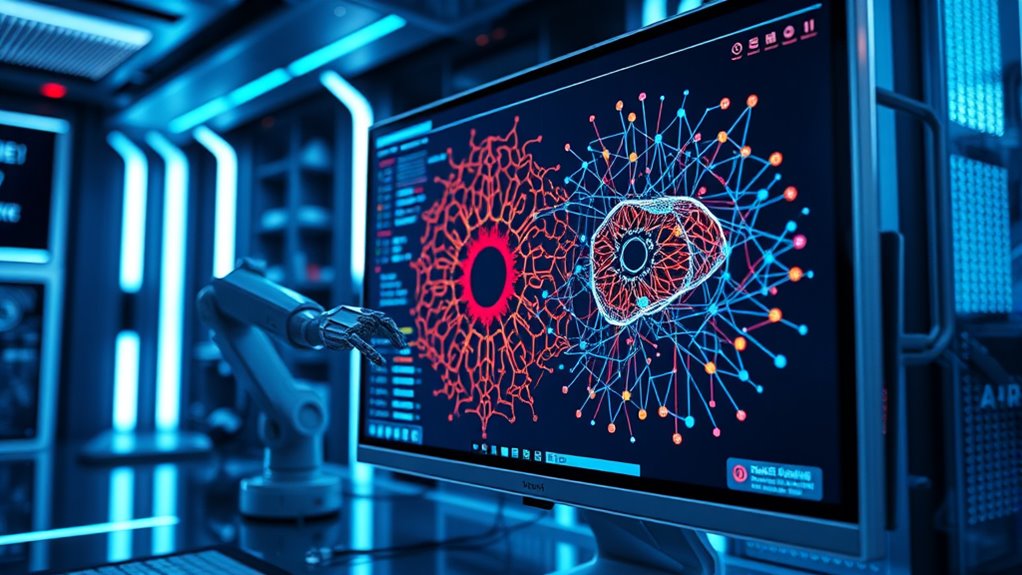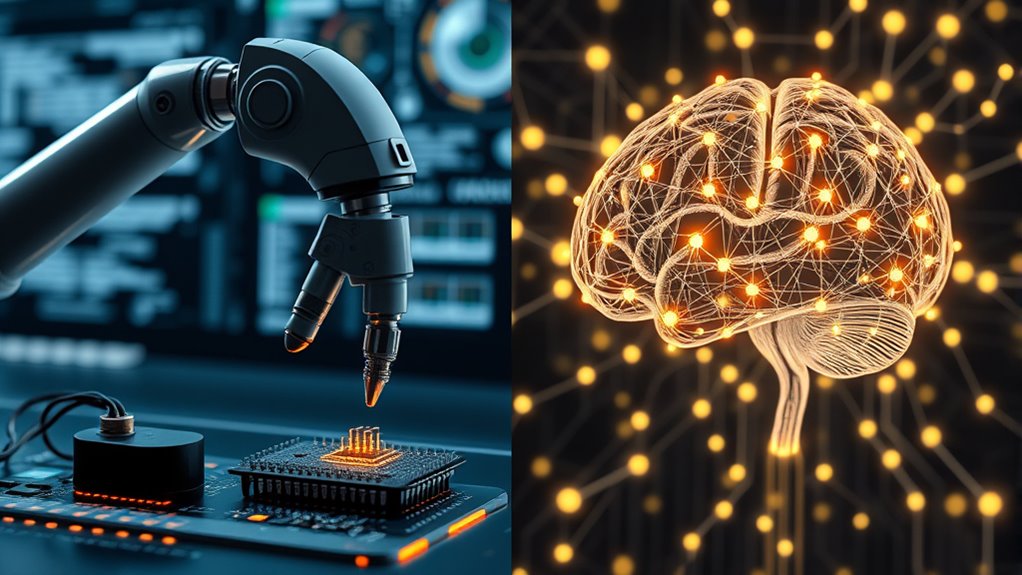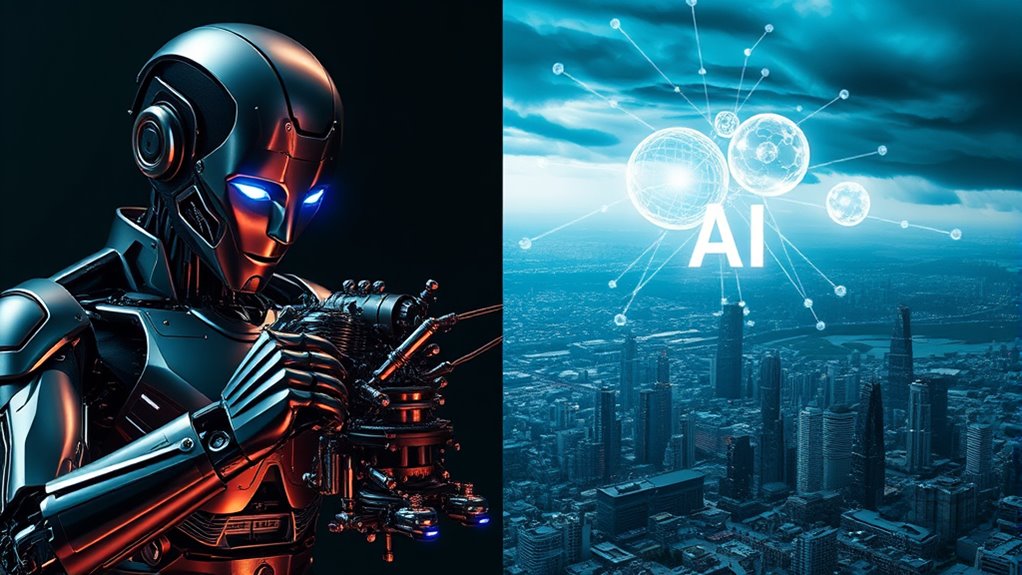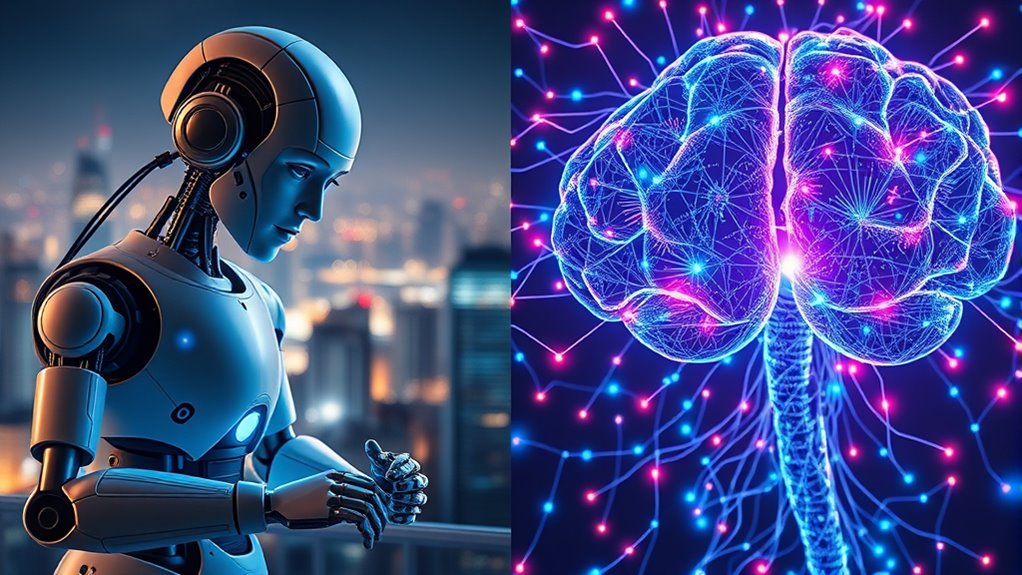Narrow AI is designed for specific tasks, like voice assistants or medical diagnosis, and improves through pattern recognition within its limited scope. In contrast, you’ll find general AI aiming to mimic human intelligence across many fields, capable of reasoning and adapting to new challenges. The key difference is that narrow AI is focused and task-specific, while general AI endeavors for broad understanding. Keep exploring to understand how these AI types impact our future and technology.
Key Takeaways
- Narrow AI is designed for specific tasks, while General AI aims to mimic human-like versatility across multiple fields.
- Narrow AI relies on pattern recognition and machine learning within a limited scope; General AI can reason and adapt broadly.
- Examples of Narrow AI include voice assistants and recommendation systems; General AI remains a theoretical goal.
- Developing General AI involves complex challenges like ethical considerations, decision-making, and ensuring alignment with human values.
- Narrow AI excels at isolated functions; General AI possesses broad understanding, learning, and problem-solving capabilities.
Defining Narrow AI and Its Capabilities

Narrow AI, also known as weak AI, refers to systems designed to perform specific tasks within a limited domain. You encounter this type of AI daily, from voice assistants to recommendation algorithms. These systems rely heavily on machine learning, allowing them to improve their performance over time through data. Pattern recognition plays a vital role, enabling the AI to identify trends and make predictions based on input data. Unlike general AI, narrow AI isn’t capable of understanding or performing tasks outside its predefined scope. Its capabilities are specialized, optimized for particular functions like image recognition, language translation, or game playing. While narrow AI can be remarkably effective, it lacks the flexibility and broader understanding that characterize human intelligence. Additionally, narrow AI’s effectiveness is often enhanced through focused training, enabling it to excel within its specific application area.
Exploring the Scope of General AI

While narrow AI excels at specialized tasks, its capabilities are confined to specific domains, leaving it unable to handle the wide-ranging intellectual activities humans perform. General AI aims to replicate this versatility by understanding, learning, and adapting across multiple fields. Imagine a system that:
- Uses machine learning to solve complex problems in science, art, and language.
- Engages in reasoning and decision-making like a human.
- Continuously learns from new experiences without predefined limits.
- Navigates ethical considerations, ensuring its actions align with human values.
Developing such systems requires careful attention to ethical considerations, ensuring that General AI benefits society without unintended consequences.
Key Differences in Functionality and Purpose

The main difference in functionality between narrow and general AI lies in their scope of capabilities. Narrow AI is designed to perform specific tasks using machine learning, excelling in areas like language translation or image recognition. It operates within predefined parameters, making it efficient but limited. In contrast, general AI aims to mimic human intelligence, understanding and adapting across a wide range of tasks. Its purpose extends beyond performing isolated functions to exhibiting reasoning, problem-solving, and learning on a broad scale. Ethical considerations also play a role, particularly in ensuring that AI systems act responsibly and transparently. While narrow AI is straightforward, general AI’s purpose involves complex decision-making and adaptability, reflecting a more all-encompassing and human-like intelligence. Additionally, advancements in AI capabilities continue to push the boundaries of what machines can achieve, emphasizing the importance of responsible development and deployment.
Examples of Narrow AI in Use Today

Many industries rely on narrow AI to handle specific tasks efficiently. For example, in healthcare, AI-powered diagnostic tools analyze medical images to detect diseases early. In finance, algorithms monitor transactions to identify fraud. In retail, chatbots assist customers with inquiries, improving AI ethics by guaranteeing respectful interactions. In transportation, autonomous vehicles use narrow AI for navigation and safety. These applications highlight how AI regulation is vital to ensure ethical use and prevent bias. You might also see AI in voice assistants like Siri or Alexa, which interpret commands accurately. Each example demonstrates how narrow AI enhances productivity while requiring ongoing oversight to address AI ethics, guaranteeing responsible deployment.
The Challenges in Developing General AI

Developing general AI presents significant challenges because it requires creating systems that can understand, learn, and adapt across a wide range of tasks, much like human intelligence. You must address complex issues like ethics considerations and data privacy, which are essential for responsible development. Ensuring the AI’s decisions align with human values is difficult, especially when it learns from vast, diverse datasets. Additionally, safeguarding sensitive information becomes more complicated as these systems process extensive personal data. Here’s a look at some core challenges:
| Challenge | Explanation | Impact |
|---|---|---|
| Ethical considerations | Ensuring AI respects human values and avoids harm | Trust and societal acceptance |
| Data privacy | Protecting personal data from misuse | Legal and reputational risks |
| Learning complexity | Developing algorithms capable of broad understanding | Technical feasibility |
| Adaptability | Enabling AI to adjust to new, unforeseen tasks | System robustness |
Furthermore, addressing the complexities of learning algorithms is vital for creating adaptable and reliable AI systems.
Potential Future Implications of Both Types

Understanding the potential future implications of narrow and general AI reveals how these technologies could reshape various aspects of society. You might see significant changes, such as:
AI’s future impacts may transform society, economy, healthcare, and ethics profoundly.
- Enhanced job automation, impacting employment and economic stability.
- Ethical considerations around decision-making, privacy, and accountability.
- Advances in healthcare, improving diagnostics and treatment options.
- Risks of AI bias or misuse, raising safety and security concerns.
- The importance of voiceover skills in communicating complex AI concepts effectively.
While narrow AI could revolutionize specific industries, general AI might lead to breakthroughs across multiple fields. However, these advancements also bring challenges, especially regarding ethical considerations and economic impacts. You’ll need to contemplate how these AIs influence job markets, societal norms, and safety protocols as they evolve. Preparing for these shifts is essential to maximize benefits and minimize risks.
How to Identify the Type of AI in Technologies

Identifying whether an AI system is narrow or general involves examining how it operates and the scope of its capabilities. Narrow AI focuses on specific tasks using techniques like machine learning and neural networks, excelling in one area but lacking flexibility. General AI, however, can understand, learn, and apply knowledge across multiple domains, similar to human intelligence. To differentiate, consider the AI’s adaptability and complexity. For example, understanding the distinction is crucial when evaluating Kia Tuning options, as some systems are designed for specific enhancements while others aim for broader performance improvements.
Frequently Asked Questions
Can Narrow AI Ever Evolve Into General AI?
You wonder if narrow AI can evolve into general AI. While AI evolution is possible through ongoing research, achieving true general AI raises significant ethical implications, like control and safety concerns. You should consider that narrow AI is designed for specific tasks, and expanding its capabilities isn’t straightforward. Developing general AI requires breakthroughs that address both technical challenges and ethical risks, making this evolution complex but potentially achievable in the future.
How Do Ethical Concerns Differ Between Narrow and General AI?
You should recognize that ethical concerns differ markedly between narrow and general AI. With narrow AI, ethical dilemmas often involve decision-making responsibilities within specific tasks, like privacy or bias. For general AI, ethical issues become more complex, involving broader decision-making responsibilities and potential impacts on society. You must consider how these systems influence human values and ensure they align with ethical standards to prevent unintended harm.
What Industries Are Most Impacted by Narrow AI Today?
You might think AI impacts only tech, but it’s transforming multiple industries today. Narrow AI excels in automated diagnostics, helping healthcare providers detect diseases faster. It also revolutionizes customer service by powering chatbots that handle inquiries efficiently. These tools save time and improve user experiences. Don’t underestimate its reach—narrow AI’s practical applications are shaping sectors like healthcare, retail, finance, and more, making processes smarter and more responsive.
How Long Might It Take to Develop True General AI?
You’re curious about how long it might take to develop true general AI. While estimates vary, many experts believe the development timeline depends on overcoming significant technological hurdles, like creating systems with human-like understanding and reasoning. Some suggest it could take decades, possibly 20 to 50 years, or longer. Progress depends on breakthroughs in AI research, resources, and collaboration, making precise predictions challenging.
Are There Hybrid Models Combining Narrow and General AI?
Ever wonder if hybrid systems combining narrow and general AI exist? They do! These AI integration models blend specialized narrow AI with adaptable general AI, creating hybrid systems that leverage strengths of both. This approach aims to make AI more versatile and efficient, pushing toward more sophisticated applications. Using hybrid models allows developers to harness the best of both worlds, improving performance and paving the way for more advanced, integrated AI solutions.
Conclusion
So, here you are, thinking you can tell if an AI is narrow or general just by its behavior. Ironically, as advanced as narrow AI gets, it still can’t truly understand or innovate like a human. Meanwhile, the dream of general AI remains just that—a dream. Maybe one day, you’ll realize that the biggest difference isn’t what these AIs do, but how much we still have to learn about what makes us truly human.









